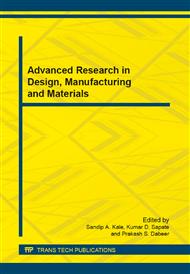p.97
p.105
p.111
p.117
p.123
p.131
p.139
p.145
p.151
Investigation of the Machinability Characteristics of GFRP / Epoxy Composites Using Taguchi Methodology
Abstract:
Many glass fiber reinforced plastic (GFRP) composite components made from primary melt processes require additional machining to meet the requirements of assembly and accurate dimensional tolerances. Importance of woven fabric based glass fibre reinforced composites is widely known in many industrial applications. However, very little is known about machinability of these composites. Cutting force is treated as one of the primary measures for determining the machinability of any material.This paper presents an investigation into the longitudinal turning of woven fabric and epoxy based GFRP composites, using polycrystalline diamond tool, so as to analyze the effect of cutting parameters and insert radius on the cutting force. The force was measured through longitudinal turning, according to the experimental plan, as developed on the basis of Taguchi methodology. The signal to noise ratio and analysis of variance were applied to the experimental data, in order to determine the effect of the process variables on tangential cutting force. Statistical results indicated that the cutting force is significantly influenced (at a 95% confidence level) by feed rate, followed by depth of cut, whereas, cutting speed and insert radius have a smaller influence. The cutting force also increases with the increase in feed rate and depth of cut.
Info:
Periodical:
Pages:
123-129
Citation:
Online since:
August 2014
Authors:
Price:
Сopyright:
© 2014 Trans Tech Publications Ltd. All Rights Reserved
Share:
Citation:


